Overview
This article highlights ten key signs of type 2 diabetes that are crucial for early detection and effective management. It's essential to be aware of symptoms such as:
- Increased thirst
- Frequent urination
- Fatigue
Recognizing these signs early can lead to timely interventions, ultimately improving health outcomes.
You're not alone in this journey. Understanding these symptoms can empower you to take action. If you notice any of these signs, please consider reaching out for support or resources. Early identification is a powerful step toward better health, and we are here to support you every step of the way.
Introduction
Recognizing the early signs of type 2 diabetes is essential for effective management and the prevention of serious health complications. With approximately 11.1% of adults living with this condition, many remain unaware of their status. This highlights a critical gap in awareness and education that we must address together.
This article explores ten key indicators that can signal the onset of type 2 diabetes. It offers valuable insights into what to look for and how to take proactive steps toward better health.
What if those symptoms that seem minor are actually warnings from your body, urging you to seek timely medical advice? You're not alone in this journey, and understanding these signs can empower you to take control of your health.
T2DSolutions: Your Essential Guide to Early Signs of Type 2 Diabetes
Recognizing the early sign of type 2 diabetes is crucial for timely intervention and effective management. Symptoms often develop gradually, frequently going unnoticed until complications arise. Key indicators to watch for as a sign of type 2 diabetes include:
- Increased thirst
- Frequent urination
- Fatigue
- Blurred vision
- Slow-healing sores
It's important to note that as many as 70% of adults with high blood sugar may experience mild loss of feeling in their extremities, which can serve as a preliminary sign of type 2 diabetes.
Currently, about 11.1% of the adult population is living with this condition, many of whom are unaware of their status—approximately 4 in 10 adults with diabetes do not know they have it. This highlights the vital need for awareness and education. Experts emphasize that prompt detection can significantly improve health outcomes. Simple lifestyle changes, such as weight management and regular physical activity, can help prevent or delay the onset of signs of type 2 diabetes.
Recent studies show that certain ethnic groups, including African Americans and Hispanics, face a higher risk, with prevalence rates of 12.1% and 11.7%, respectively. Additionally, having a family history of this illness increases one's risk; offspring of parents diagnosed before age 50 have a 1 in 7 chance of developing the condition themselves.
Effective interventions for prompt detection include:
- Regular health screenings
- Consultations with healthcare providers
- Engaging with health educators for valuable insights on effectively managing risk factors
Research indicates that 1 out of 3 adults has prediabetes, underscoring the significance of timely intervention. By recognizing these early indicators and seeking prompt medical advice, individuals can take proactive steps toward better health and effective management of their condition.
At T2DSolutions, we are dedicated to providing resources and support for those navigating diabetes. You're not alone in this journey—we encourage you to subscribe to our updates for more information on managing your health and accessing community support.
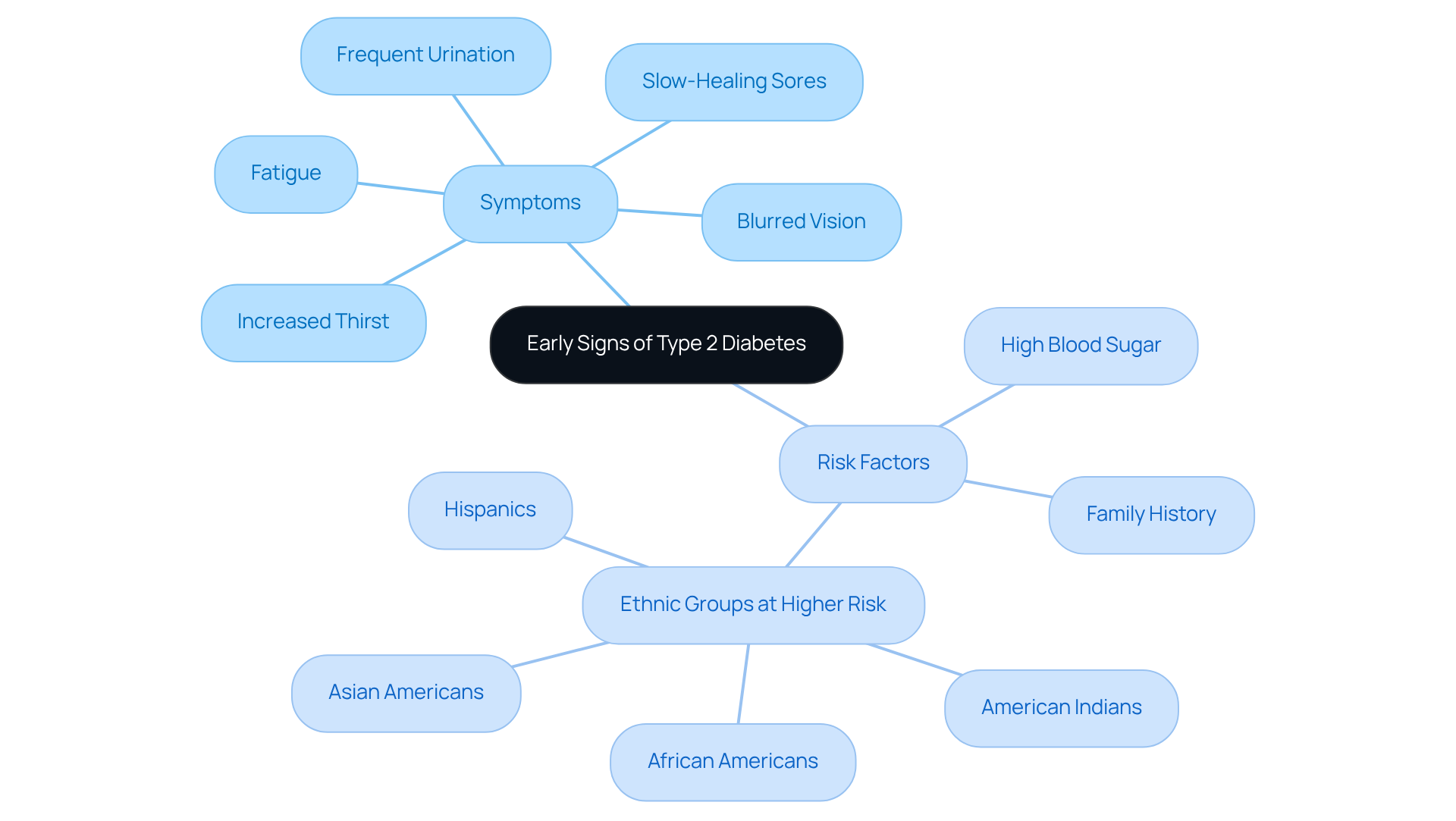
Frequent Urination: A Key Indicator of Type 2 Diabetes
Frequent urination, known as polyuria, can be a concerning sign of type 2 diabetes. This condition arises when the kidneys struggle to reabsorb glucose efficiently, resulting in increased glucose levels in the urine. As your body works to eliminate this excess glucose, it leads to more frequent bathroom visits, especially at night. It's understandable to feel worried if you're experiencing this.
Research indicates that polyuria is often linked with elevated blood sugar levels, making it a critical early warning sign of type 2 diabetes. In fact, many newly diagnosed patients report polyuria as a sign of type 2 diabetes, alongside other symptoms such as:
- Increased thirst (polydipsia)
- Heightened appetite (polyphagia)
If you've noticed a change in your urination habits, particularly if it's affecting your sleep, please consult a healthcare professional promptly for further assessment and possible testing.
Identifying polyuria early can significantly aid in diagnosis and management, ultimately improving your health outcomes. Remember, you're not alone in this journey. For more information on understanding symptoms and managing your condition, T2DSolutions offers valuable resources and support to help you every step of the way.
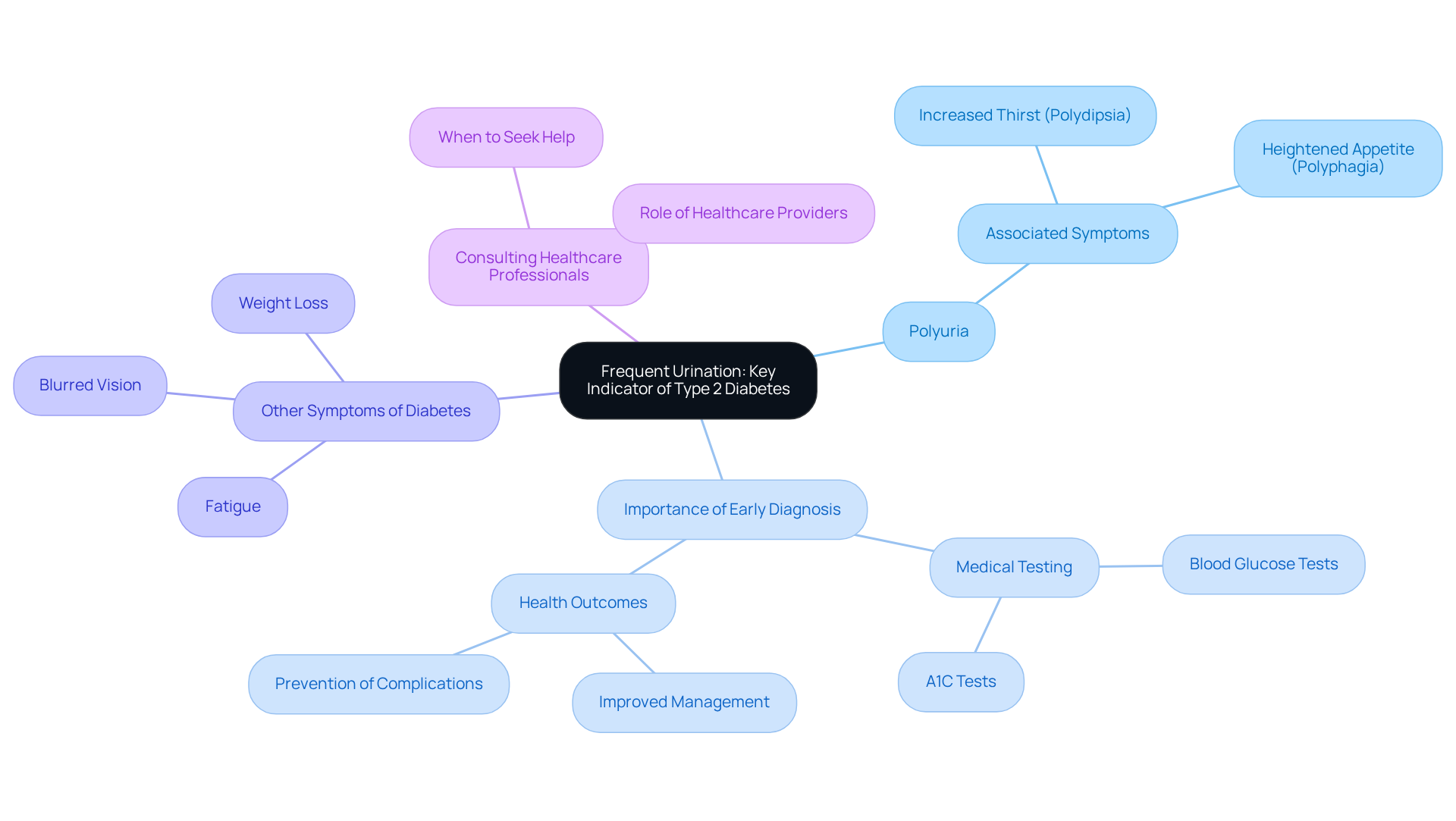
Increased Thirst: Recognizing a Common Early Symptom
Increased thirst, known as polydipsia, can often accompany frequent urination. It's understandable to feel concerned when your body signals a need for hydration, especially when you find yourself feeling thirsty all the time, even after drinking. This persistent thirst could be a sign of type 2 diabetes, suggesting that your body is trying to compensate for lost fluids due to high blood sugar levels.
As your body loses more fluids, it sends signals to your brain, urging you to seek out hydration. Remember, you're not alone in this journey. Many people experience similar symptoms, and it's important to listen to your body. If you have any questions or concerns, seeking support and resources can be a helpful step toward understanding and managing your health.
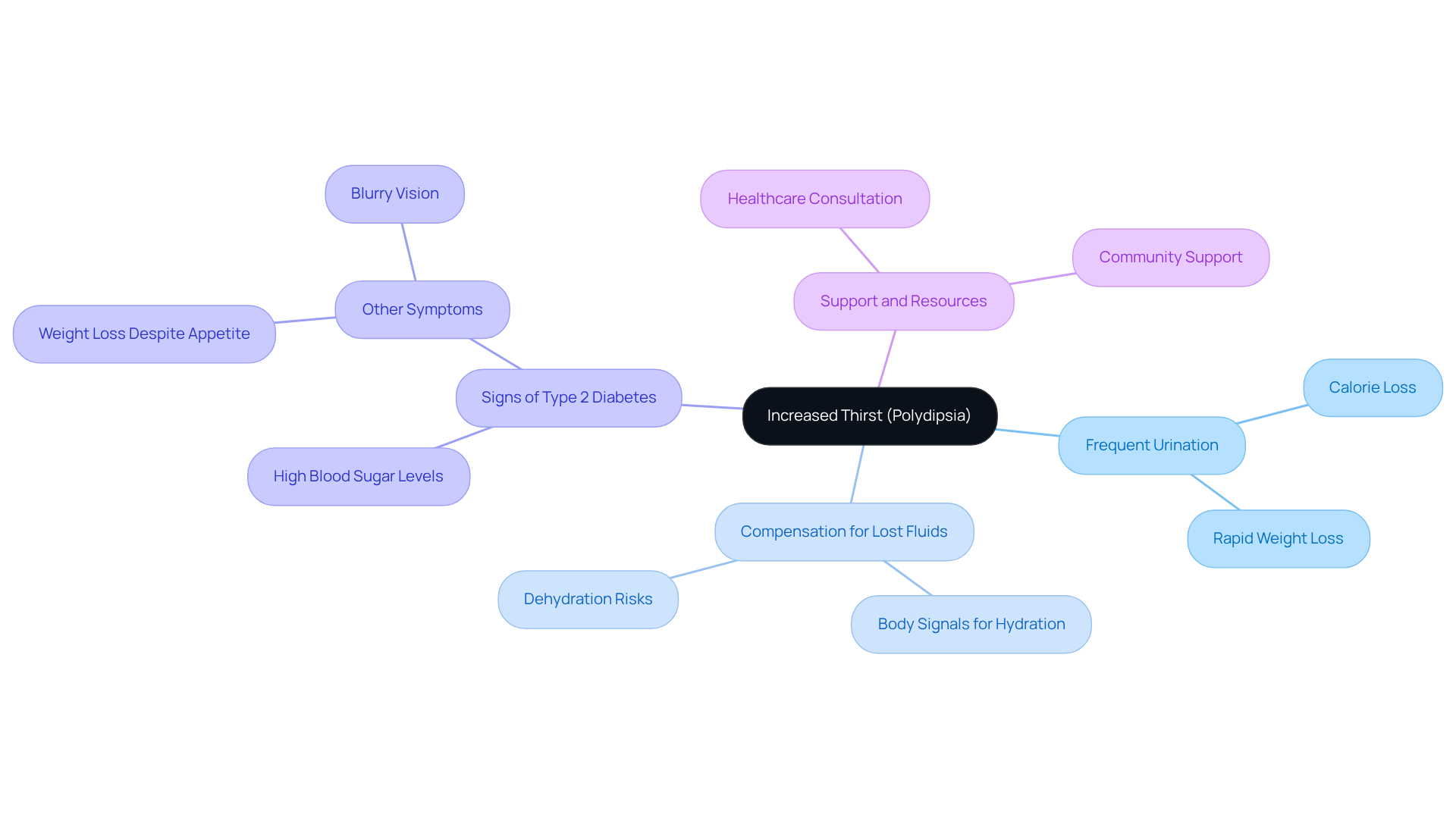
Frequent Hunger: Understanding This Early Warning Sign
Frequent hunger, known as polyphagia, can be a significant sign of type 2 diabetes. It arises from the body's struggle to effectively utilize glucose for energy. When insulin resistance occurs, cells cannot absorb glucose, leading to persistent feelings of hunger even after meals. This condition is more than just a nuisance; it reflects a deeper metabolic issue that can escalate if left unaddressed.
It's important to recognize that approximately 22% of U.S. adults over 20 years old experience insulin resistance, a precursor to Type 2 Diabetes. Additionally, research suggests that nearly 40% of young adults without this condition may also show signs of insulin resistance. This highlights the importance of early detection and intervention.
Nutritionists stress that polyphagia may indicate underlying health problems, especially when it’s accompanied by other symptoms like fatigue and frequent urination. Many individuals managing their condition share that frequent hunger is a daily challenge, often leading to overeating or unhealthy food choices. Identifying polyphagia as a sign of type 2 diabetes is essential; it encourages individuals to seek medical guidance and consider lifestyle modifications to improve their metabolic health.
Addressing frequent hunger through dietary adjustments, such as incorporating more fiber and protein, can help stabilize blood sugar levels and reduce the sensation of hunger. You're not alone in this journey; we are here to support you every step of the way. By taking these proactive steps, you can aid in diabetes management and enhance your overall well-being.
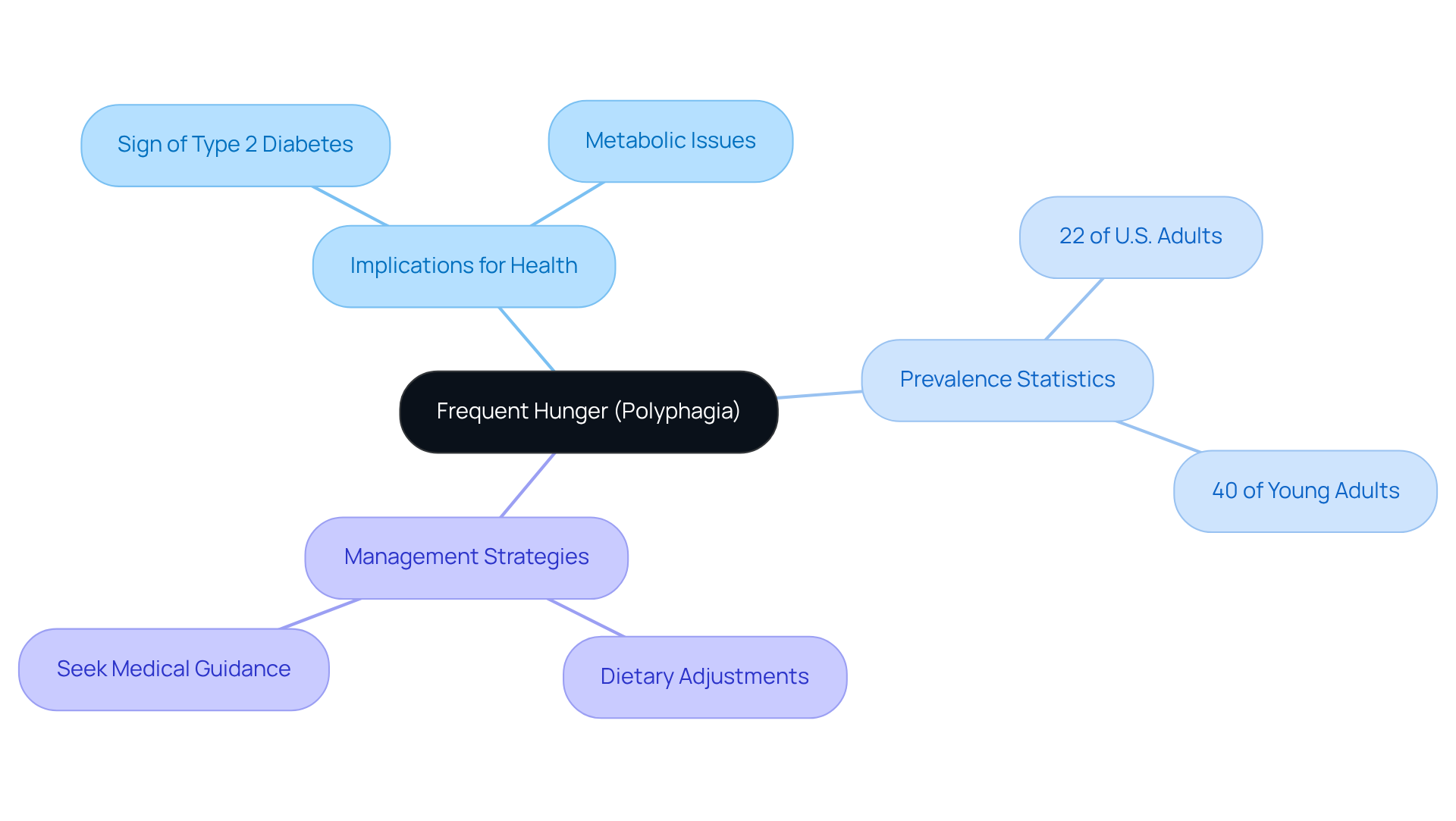
Fatigue: An Often Ignored Early Sign of Type 2 Diabetes
Fatigue is a common symptom of type 2 diabetes, often stemming from the body's struggle to utilize glucose for energy. When blood sugar levels fluctuate unpredictably, it can lead to feelings of deep fatigue, even after a full night's sleep. If you’re experiencing unusual fatigue, it’s important to discuss this with your healthcare provider. You're not alone in this journey.
At T2DSolutions, we recognize that managing fatigue is vital for those newly diagnosed with diabetes. We offer resources and support to help you navigate this challenge. Consider incorporating a balanced diet rich in whole grains and engaging in regular physical activity, as these lifestyle choices can significantly boost your energy levels. Additionally, our community support can provide you with strategies and encouragement to effectively manage fatigue.
Recognizing fatigue as a sign of type 2 diabetes is essential for effective management and improving your quality of life. Engaging with healthcare professionals about these symptoms can lead to better strategies for managing your energy and enhancing your daily activities. Remember, we are here to support you every step of the way.
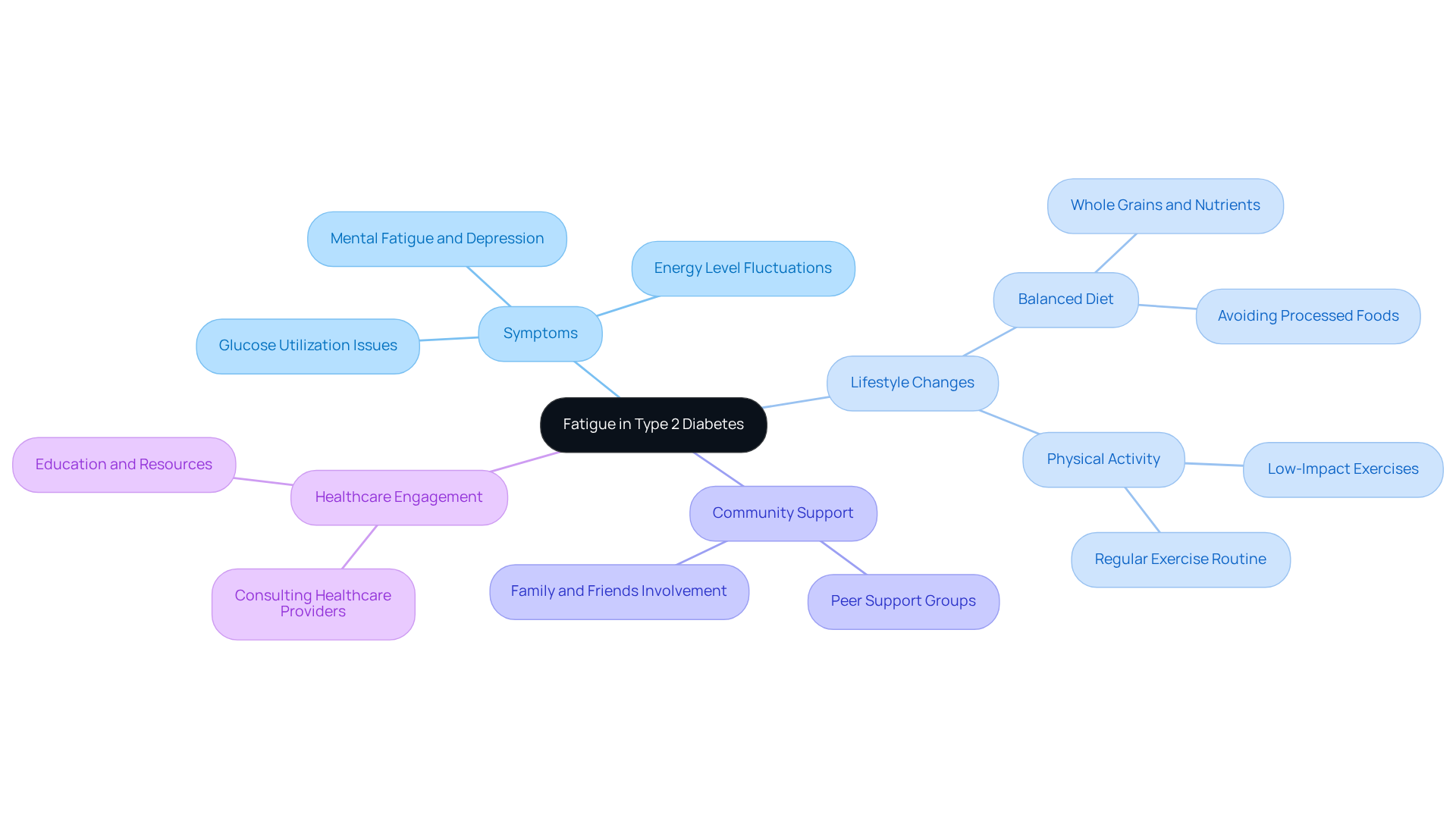
Blurry Vision: A Serious Early Sign of Type 2 Diabetes
Blurry vision can be a sign of type 2 diabetes, often resulting from elevated blood sugar levels that cause the lenses of the eyes to swell. This swelling may hinder your ability to focus clearly, leading to temporary vision disturbances. It's important to recognize that these changes could be a sign of type 2 diabetes, as they may indicate poorly controlled blood sugar levels, which can have serious long-term effects on your eye health.
Many individuals have shared their experiences with sudden blurriness, prompting them to seek medical help. Ophthalmologists emphasize that these symptoms should not be ignored, as they may be a sign of type 2 diabetes, which can lead to diabetic retinopathy—a condition affecting approximately 9.6 million people in the U.S. living with diabetes. If left unaddressed, this condition can result in significant vision loss.
Recent studies reveal that nearly 11.8% of adults diagnosed with blood sugar issues face severe vision difficulties or blindness. This statistic highlights the prevalence of vision changes among those with elevated blood sugar levels. If you notice any sudden changes in your eyesight, it’s crucial to consult a healthcare professional right away. They can assess your blood sugar levels and discuss appropriate management strategies.
Remember, you're not alone in this journey. T2DSolutions is here to provide you with resources and information to effectively manage your condition. We want to ensure you have the tools needed to address symptoms like blurry vision and maintain your overall health.
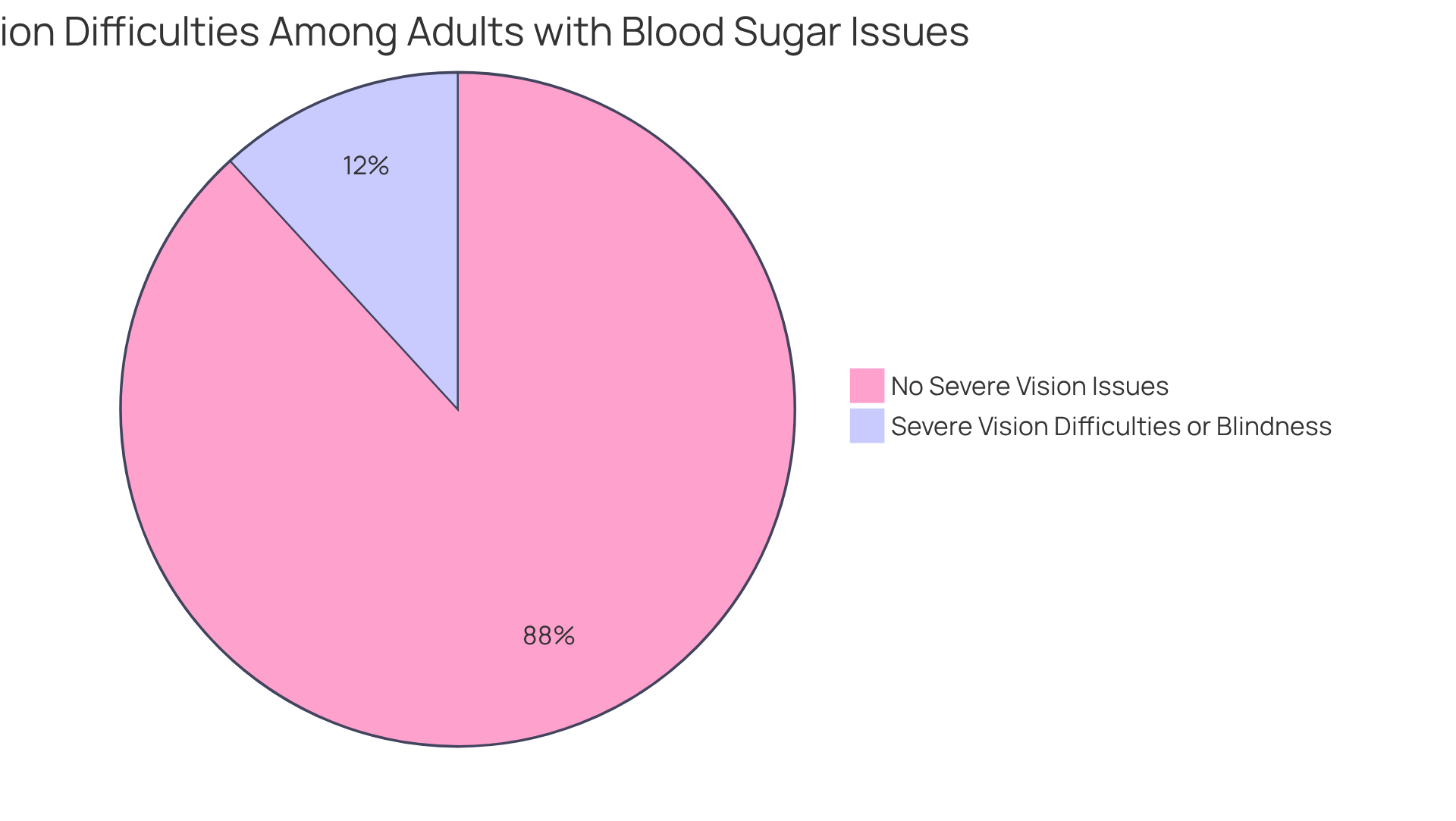
Slow Healing of Cuts: An Important Early Indicator
Experiencing cuts and bruises that heal unusually slowly can be concerning, as it may be a sign of type 2 diabetes related to a metabolic disorder. Elevated blood sugar levels can disrupt circulation, making it harder for your body to heal naturally. This can lead to prolonged recovery times for wounds. It's important to know that individuals with signs of type 2 diabetes are at a heightened risk for chronic wounds, with approximately 15% developing such complications.
You might find it reassuring to learn that studies show up to 50% of diabetic foot ulcer cases can be prevented with proper education and timely intervention. Wound care experts emphasize the need for prompt evaluation of any slow-healing wounds. Neglected injuries can lead to serious complications, including infections and possible amputations.
If you notice persistent slow healing, especially with frequent injuries, please consult a healthcare professional for evaluation and management. You're not alone in this journey; we are here to support you every step of the way.
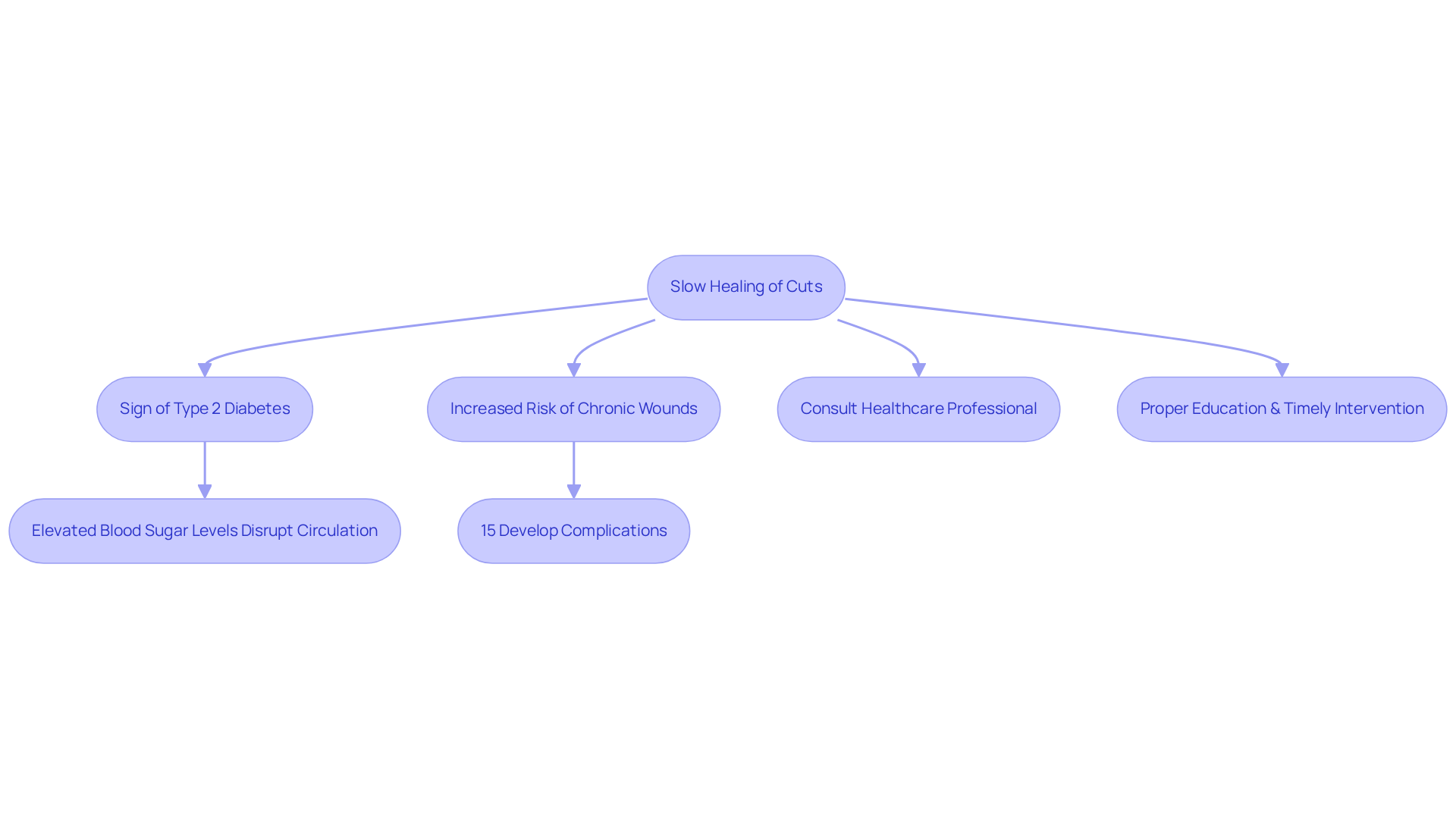
Tingling and Numbness: Recognizing Neuropathy as an Early Sign
Tingling and numbness, especially in the hands and feet, are often among the first signs of diabetic neuropathy. This condition arises when prolonged high blood sugar levels inflict damage on the nerves. You might experience a range of sensations, including a burning feeling or loss of sensation, which can significantly impact your daily life. Recent research indicates that around 18% of newly identified individuals with Type 2 diabetes exhibit a sign of type 2 diabetes aligned with diabetic peripheral neuropathy (DPN). This occurrence may rise to as much as 26.52% among newly diagnosed patients, emphasizing the necessity for awareness and prompt intervention.
It's understandable to feel concerned about these indications. Neurologists stress that they should not be disregarded. As Dr. Andrei Cristian Bondar states, 'The prevalence of diabetic neuropathy is significantly higher in patients with type 2 diabetes, making it a critical sign of type 2 diabetes that requires early detection.' Persistent tingling or numbness can indicate underlying nerve damage, which, if left unaddressed, may progress to more severe complications, including foot ulcers and an increased risk of amputation. Real-world examples illustrate the challenges faced by newly diagnosed patients. Many report that the initial tingling sensations were dismissed as minor issues, only to later discover they were indicative of more serious nerve damage.
Therefore, if you experience these symptoms, it is essential to consult with your healthcare provider promptly. You're not alone in this journey. Prompt identification and handling can greatly enhance outcomes and improve the quality of life for individuals affected by this condition. For further assistance and resources, T2DSolutions is available to offer guidance and education on managing the condition effectively. We are here to support you every step of the way.
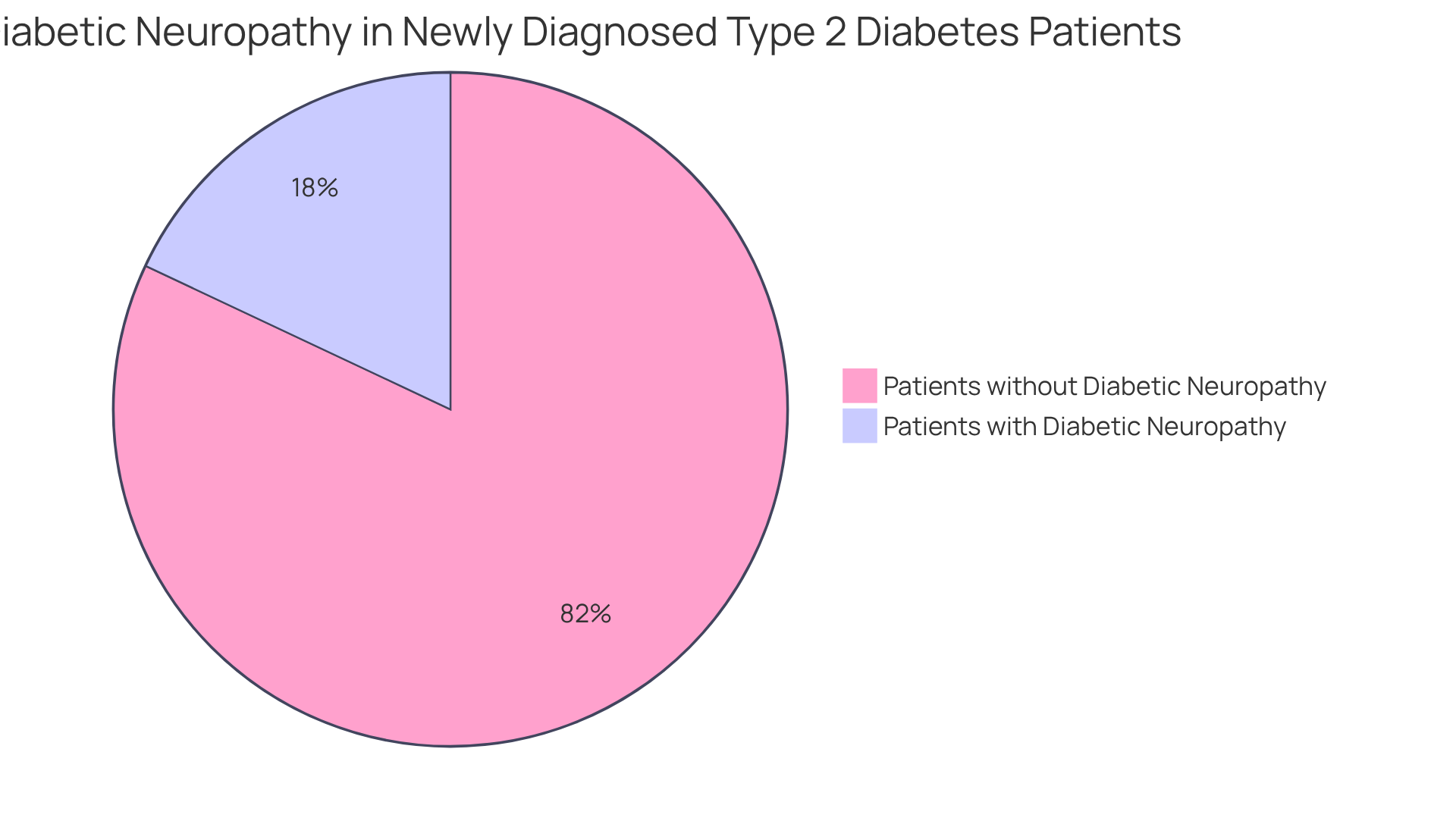
Patches of Darker Skin: A Unique Early Sign of Type 2 Diabetes
Acanthosis nigricans is more than just a skin condition; it’s a sign that deserves your attention. Characterized by dark, velvety patches, it often appears in areas like the neck, armpits, and groin. This condition is closely linked to insulin resistance, which affects many people, often without them realizing it. In fact, nearly five million individuals in the UK are living with this condition, with over four million diagnosed with Type 2 diabetes. Recognizing acanthosis nigricans can be crucial, as it may serve as a sign of type 2 diabetes, acting as an early warning for this chronic ailment.
At T2DSolutions, we understand how overwhelming it can be to navigate health concerns. We are dedicated to providing valuable resources and education for those managing their health. Dermatologists emphasize that these skin changes should not be overlooked; they may indicate underlying metabolic issues that require medical attention. If you notice these changes, please don’t hesitate to consult a healthcare professional for further evaluation.
Recent studies reveal that the prevalence of acanthosis nigricans is influenced by factors such as ethnicity and body mass index (BMI). For instance, it occurs in:
- 52.6% of African-American individuals
- 35.9% of Latin-American individuals, particularly among those with a higher BMI
Identifying these skin alterations early can be vital for prompt intervention and management of the condition.
You’re not alone in this journey. For additional details on managing blood sugar levels and further education, we encourage you to explore the resources available at T2DSolutions. Remember, we are here to support you every step of the way.
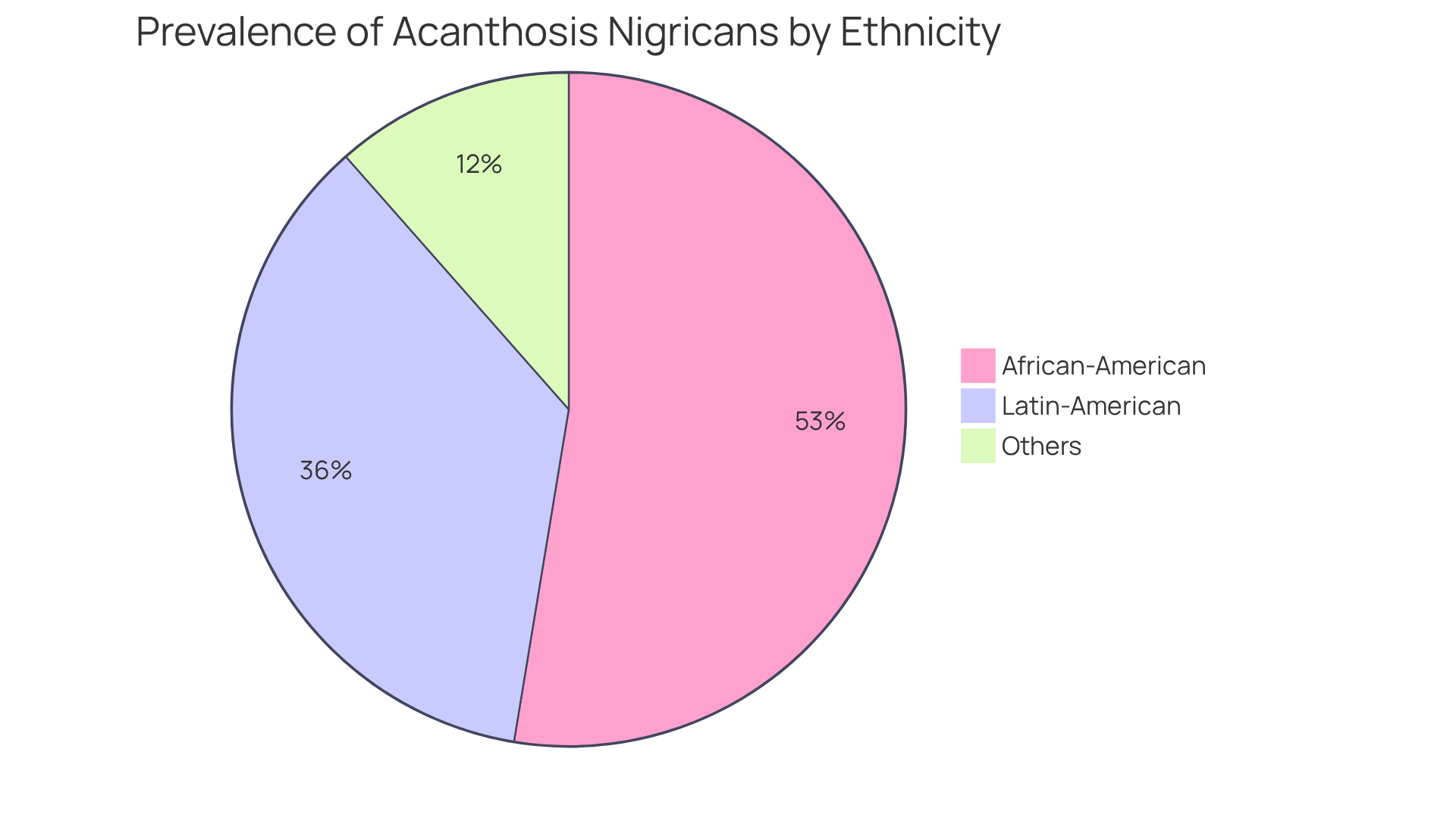
Itching and Yeast Infections: Recognizing These Early Symptoms
Itching and Yeast Infections: Recognizing These Early Symptoms
If you have diabetes, you might find yourself dealing with frequent itching and recurrent yeast infections. This can be distressing, and it's important to understand that elevated blood sugar levels can create an environment where yeast thrives, leading to infections. In fact, research shows that yeast infections are twice as common among those with high blood sugar compared to the general population. If you're experiencing persistent itching or frequent infections, please reach out to a healthcare professional as these symptoms may be a sign of type 2 diabetes and to evaluate your blood sugar levels. As Dr. Alana Biggers reminds us, 'If you have this condition, it’s important to consult with a physician regarding routine screenings for vaginal yeast infections.'
Managing these symptoms effectively starts with good hygiene and a healthy lifestyle. Consider incorporating:
- A balanced diet
- Regular exercise
- Proper hydration
into your daily routine. You're not alone in this journey; many find that educational resources through T2DSolutions can provide valuable guidance on managing diabetes and preventing complications. Remember, taking these steps can make a significant difference in your health and well-being.
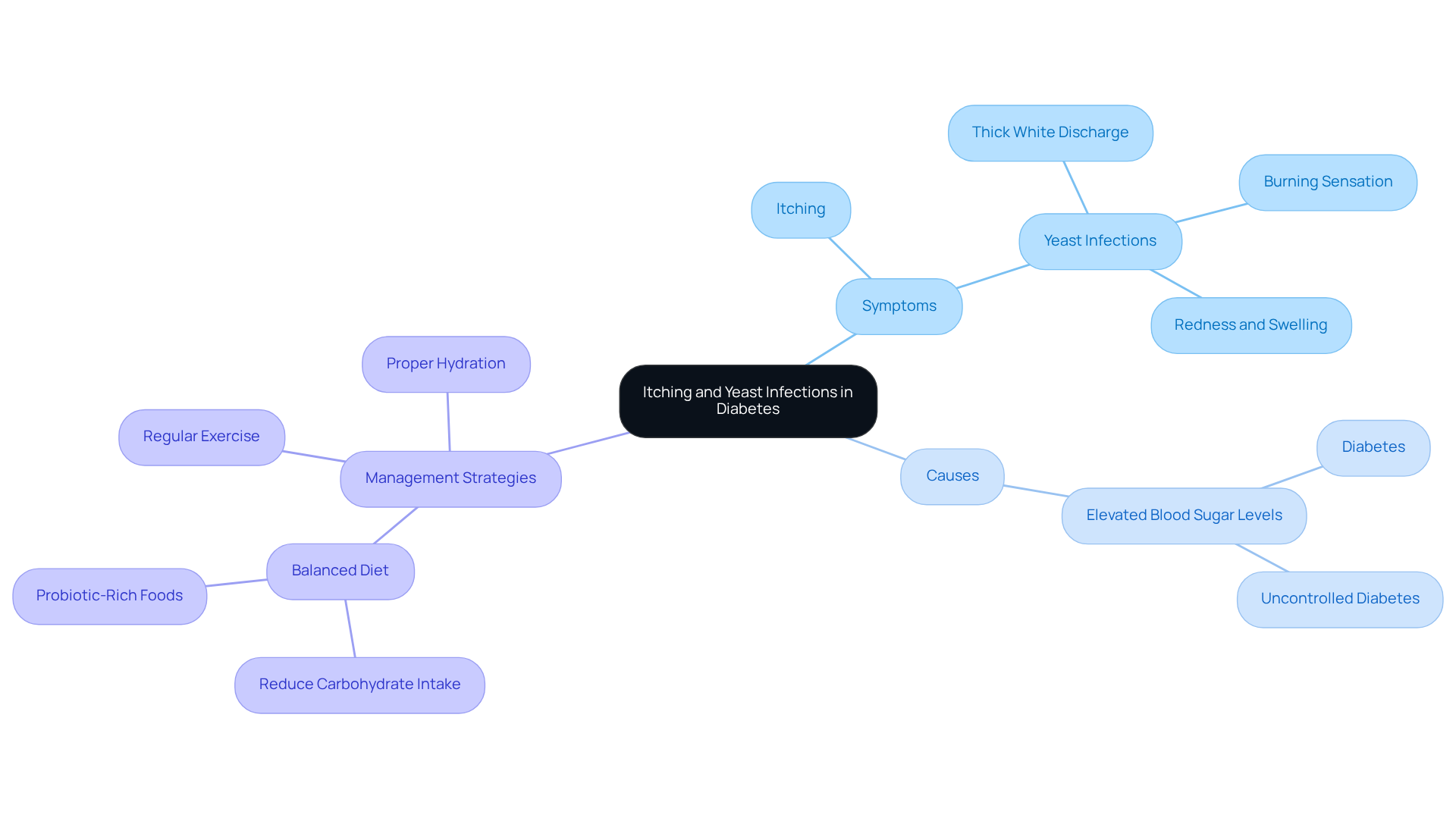
Conclusion
Recognizing the early signs of type 2 diabetes is essential for effective management and prevention of complications. It's understandable to feel overwhelmed by this information, but knowing the critical indicators—such as increased thirst, frequent urination, fatigue, and blurred vision—can empower you to take action. By understanding these symptoms, you can seek timely medical advice and make necessary lifestyle changes.
Many adults remain unaware of their diabetes status, with approximately 40% of those affected not recognizing the symptoms. This is why regular health screenings and consultations with healthcare providers are so important. Additionally, certain ethnic groups face heightened risks, and family history can significantly impact susceptibility to diabetes.
Ultimately, awareness and education are vital in combating type 2 diabetes. By recognizing the signs and taking proactive measures, you can significantly improve your health outcomes. Remember, you’re not alone in this journey. Engaging with resources like T2DSolutions can provide essential support and guidance. It's crucial to prioritize your health and seek the necessary interventions to manage risk factors effectively. Together, we can navigate this path toward better health.
Frequently Asked Questions
What are the early signs of type 2 diabetes?
Early signs of type 2 diabetes include increased thirst, frequent urination, fatigue, blurred vision, and slow-healing sores. Additionally, about 70% of adults with high blood sugar may experience mild loss of feeling in their extremities.
How prevalent is type 2 diabetes among adults?
Approximately 11.1% of the adult population is living with type 2 diabetes, and about 4 in 10 adults with diabetes are unaware of their condition.
What factors increase the risk of developing type 2 diabetes?
Factors that increase the risk include being part of certain ethnic groups (such as African Americans and Hispanics), having a family history of diabetes, and being overweight. The prevalence rates for African Americans and Hispanics are 12.1% and 11.7%, respectively.
What lifestyle changes can help prevent or delay the onset of type 2 diabetes?
Simple lifestyle changes such as weight management and regular physical activity can help prevent or delay the onset of type 2 diabetes.
How can individuals ensure timely detection of type 2 diabetes?
Individuals can ensure timely detection by engaging in regular health screenings, consulting with healthcare providers, and working with health educators to manage risk factors.
What is polyuria and how is it related to type 2 diabetes?
Polyuria, or frequent urination, occurs when the kidneys struggle to reabsorb glucose efficiently, leading to increased glucose levels in urine. It is often linked with elevated blood sugar levels and is a critical early warning sign of type 2 diabetes.
What should I do if I notice changes in my urination habits?
If you notice changes in your urination habits, particularly if it affects your sleep, it is important to consult a healthcare professional for further assessment and possible testing.
What does increased thirst indicate in relation to type 2 diabetes?
Increased thirst, or polydipsia, may indicate that your body is compensating for lost fluids due to high blood sugar levels, suggesting a potential risk for type 2 diabetes.
Where can I find resources and support for managing diabetes?
T2DSolutions provides resources and support for individuals navigating diabetes, offering valuable information on managing health and accessing community support.



